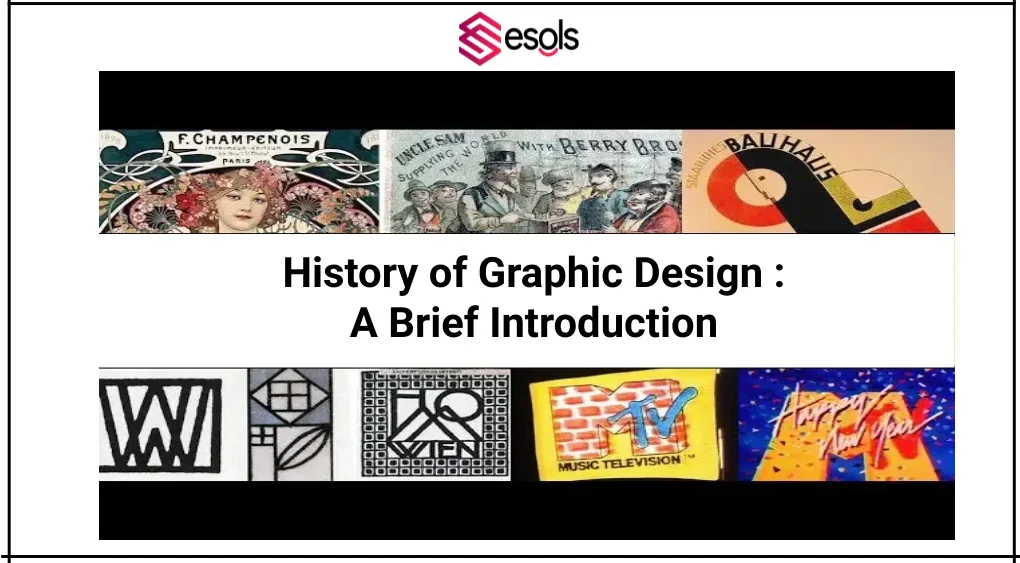Graphic design, an artistic and communicative medium, has a rich history that intertwines with human expression and technological advancement. From its inception to its current state, the evolution of graphic design reflects the ever-changing landscape of creativity and visual communication.
Table of contents
What is Graphic Design?
At its core, graphic design is the art of visual communication. It combines imagery, typography, and various design elements to convey ideas, messages, and concepts. From advertisements to logos, graphic design permeates our daily lives, shaping perceptions and facilitating understanding.

Importance and Evolution
The roots of graphic design can be traced back to ancient civilizations. Hieroglyphs in Egypt and calligraphy in China exemplify early forms of visual communication. However, the significant leap occurred with Johannes Gutenberg’s invention of the printing press in the 15th century, revolutionizing mass communication and paving the way for printed materials.
Early History of Graphic Design

Origins and Ancient Influences
Ancient civilizations utilized symbols, drawings, and visual elements to convey information. The cave paintings of Lascaux and Mesopotamian clay tablets are early examples of visual storytelling and communication.

Gutenberg’s Printing Press Revolution
The advent of the printing press in the 15th century marked a turning point in graphic design. It enabled the mass production of books, leading to the standardization of fonts and layout design, significantly impacting the spread of knowledge and ideas.
The Development of Graphic Design in the 20th Century

Art Nouveau and Avant-Garde Movements
The 20th century witnessed artistic movements like Art Nouveau and art Deco , characterized by intricate designs and organic forms, and the Avant-Garde movements challenging traditional design norms, pushing boundaries and embracing new artistic approaches.
Bauhaus and Modernism
The Bauhaus school emerged, emphasizing simplicity, functionality, and the marriage of art and technology. however , This period laid the foundation for modernist design principles that still influence contemporary graphic design.
Graphic Design in the Digital Age
Computer Revolution and Impact
The introduction of computers and design software transformed the industry, allowing designers to explore new creative realms, manipulate images, and enhance precision in design.

Role of Technology in Shaping Design
Digital age transforms design with UX and responsive techniques, shaping how designers engage audiences across diverse digital platforms.
Key Figures and Movements in Graphic Design History
Icons like Paul Rand, Saul Bass, and Milton Glaser revolutionized design with legendary logos and innovative concepts, shaping the industry.
| Key Figure | Contribution |
| Paul Rand | Pioneer of corporate identity design; created iconic logos for IBM, ABC, and UPS; emphasized simplicity, memorable visuals, and timeless design principles. |
| Saul Bass | Known for iconic film title sequences (e.g., “Psycho,” “Vertigo”); redefined visual storytelling in cinema; designed timeless logos (e.g., AT&T, Kleenex) with a focus on symbolism and impact. |
| Milton Glaser | Created the “I ❤ NY” logo, a globally recognized symbol; co-founded New York Magazine; emphasized versatility and creativity in design; known for diverse artistic styles. |
| Art Nouveau Movement | Emphasized organic forms, decorative elements, and intricate details; influenced typography, illustration, and poster design in the late 19th to early 20th century. |
| Bauhaus Movement | Focused on merging art with functionality; emphasized simplicity, geometric forms, and experimentation; shaped modern design education and influenced various design disciplines. |
| Swiss Style | Known for clean typography, grid-based layouts, and clarity; promoted the use of sans-serif typefaces and asymmetrical designs; emphasized information hierarchy and readability. |
Role of Graphic Design in Society
Commercial Applications
Graphic design plays a pivotal role in marketing, advertising, and branding, influencing consumer behavior and establishing brand identities that resonate with audiences.

Influence on Culture and Communication
From political posters to social media visuals, graphic design shapes cultural narratives, communicates ideologies, and facilitates meaningful conversations across diverse audiences.
Future Trends in Graphic Design
Emerging Technologies and Design
Advancements in artificial intelligence, augmented reality, and immersive experiences are poised to redefine the possibilities in graphic design, offering innovative ways to engage audiences.
Sustainability and Ethical Design Practices
There’s a growing emphasis on sustainable design practices and ethical considerations, advocating for responsible design choices to minimize environmental impact.
Conclusion
The journey through the history of graphic design showcases its transformative evolution, from ancient symbols to digital landscapes. Discover the timeless influence of graphic design, seamlessly blending artistry and communication, shaping our evolving world.
Readmore : How Much Does PPC Cost?
FAQS
Graphic design involves several key elements, in Addition :
Line:
Color:
Typography:
Layout:
Imagery/Illustration:
Technology has revolutionized graphic design by:
Introducing design software for more precise and efficient creation. Enabling digital design, making it accessible across various platforms.
Graphic design is crucial in branding as it: Creates visual identities that represent a brand’s values and personality.




